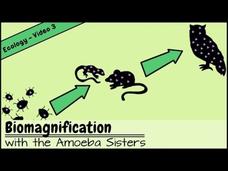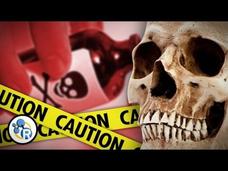TED-Ed
TED-Ed: The life cycle of a pair of jeans | Madhavi Venkatesan
The first pairs of jeans were designed for durability; denim was constructed as a sturdy weave worn by sailors and miners. But over the course of the 20th century, as the demand for jeans has gone up, their durability has gone down....
TED Talks
TED: A secret weapon against Zika and other mosquito-borne diseases | Nina Fedoroff
Where did Zika come from, and what can we do about it? Molecular biologist Nina Fedoroff takes us around the world to understand Zika's origins and how it spread, proposing a controversial way to stop the virus -- and other deadly...
TED Talks
Susan Shaw: The oil spill's toxic trade-off
Break down the oil slick, keep it off the shores: that's grounds for pumping toxic dispersant into the Gulf, say clean-up overseers. Susan Shaw shows evidence it's sparing some beaches only at devastating cost to the health of the deep sea.
MinuteEarth
Why Sewers Around the World Keep Overflowing
The old combined sewer systems of many major cities are no match for modern storms and impermeable surfaces.
Curated Video
Phagocyte
A white blood cell that helps protect the body by engulfing and absorbing harmful bacteria, dead or dying cells, waste material, or other foreign bodies in the bloodstream and tissues. A Twig Science Glossary Film. Key scientific terms...
Curated Video
Chemical Filtration
We look at how chemical filtration can be used to remove contaminants from water. Potassium permanganate is used as the contaminant. First, we try to remove it using physical filtration, with filter paper and a funnel. This does not...
Wonderscape
The Environmental and Human Costs of Industrial Cobalt Mining in the DRC
Delve into the complexities of cobalt mining in the Democratic Republic of the Congo (DRC), where industrial and artisanal mining intersect. Learn about the environmental damage, displacement of communities, and health risks associated...
Curated Video
Pollution and You
Dr. Forrester explains different types of pollution: water, air, and noise.
Wonderscape
The Ocean's Plastic Plague: Causes, Consequences, and Solutions
Explore the causes of plastic pollution in our oceans, driven by ocean currents and gyres. Learn about the staggering scale of the Great Pacific Garbage Patch and the proliferation of microplastics. Understand the environmental and...
Curated Video
GCSE Biology - How Human Waste Reduces Biodiversity - Explained #89
We explain what you need to know about how biodiversity suffers as a result of human activity.
Curated Video
Hydraulic Fracturing
Hydraulic Fracturing explains what hydraulic fracturing is and why it is a highly controversial process by explaining the advantages and disadvantages of fracking.
Wonderscape
Science Kids: Plastic and Chemical Pollution in Oceans
This video discusses the significant sources of pollution in our oceans, focusing on the impact of chemical waste and plastic pollution. It highlights the consequences of pollution on marine life, human health, and the environment. The...
Next Animation Studio
Killer whales threatened by PCBs in ocean
Toxic chemical polychlorinated biphenyls, or PCBs, were found lingering in marine life such as killer whales, according to a new study published in the journal Science.
Next Animation Studio
Dental floss could be linked to toxic chemicals, study finds
Certain types of dental floss may increase the amount of toxic chemicals present in the body, according to a new study published in the Journal of Exposure Science & Environmental Epidemiology.
Next Animation Studio
RNA-based plant vaccine could supplant chemical pesticides
Conventional pesticides are a double-edged sword that scientists are now seeking to replace with more natural RNA-based plant vaccines. The U.S. Department of Agriculture estimates that without pesticides, roughly 70 percent of the...
Mazz Media
Bioaccumulation
This live-action video program is about bioaccumulation. The program is designed to reinforce and support a student's comprehension and retention of the term through use of video footage, photographs, diagrams and colorful, animated...
TED-Ed
How One Scientist Took on the Chemical Industry
Rachel Carson's exposure to the dangers of chemical pesticides in Silent Spring not only lead to the development of the Environment Protection Agency, but also to her being accused of being a mass murderer due to the ban on DDT....
Howard Hughes Medical Institute
Motor Cabal Toxins Block Motor Neuron Synapses
Cone snails release four different toxins, each capable of paralyzing a fish. An animation demonstrates that the toxins work independently, and then explains the impact of this redundant system on the nervous system.
Amoeba Sisters
Biomagnification and the Trouble with Toxins
Our relationship with toxins is, well, a little toxic. Explore how harmful substances work their way throughout the environment with a video from an expansive biology playlist. Topics include DDT and mercury, trophic levels, and water...
American Chemical Society
How Much Water Can Kill You?
Can water really poison you? An episode of the ACS Reaction series verifies that water can be toxic in large amounts. In fact, this is the main idea of the lesson: all elements are toxic at the right dose.
Deep Look
This Mushroom Starts Killing You Before You Even Realize It
Death cap mushrooms cause the most fatal mushroom poisonings worldwide. The video explains where they grow, how the toxin works, and how our bodies react to eating them. Then, it offers a glimpse into the research scientists are doing to...
Fuse School
Green Chemistry - Principle 5
How important is lab safety, anyway? And, how do chemical manufacturers create safe lab environments? Chemistry scholars learn the importance of minimizing risks where the stakes are often highest—the chemical industry—in the fifth...
SciShow
Rare Earth Elements
Lanthanides are a group of rare earth elements found at the bottom of the periodic table that are needed for cars, computers, phones and most other technology that we use daily. A video discusses where these elements are found and...
SciShow
Top 5 Deadliest Substances on Earth
A crystal, the size of a grain of sand, of botulinum can kill 9,600 people. Viewers learn more about the five deadliest natural substances based on their ability to kill quickly with a video that also explains how these substances are...








